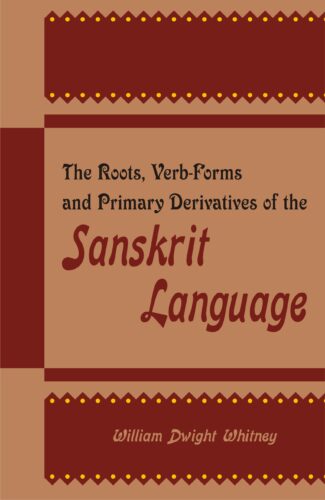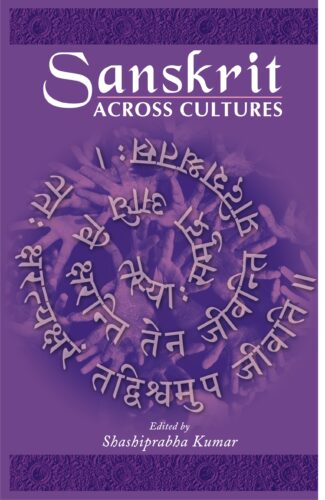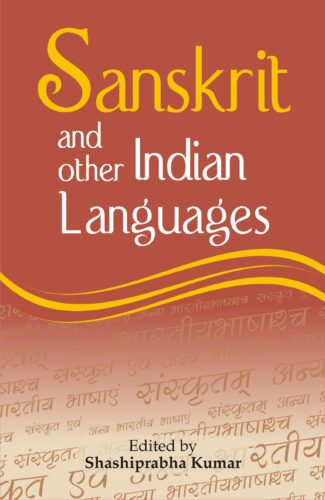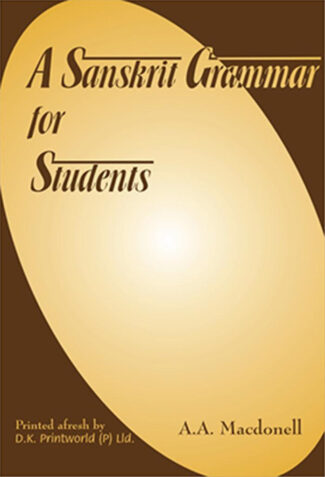Showing 25–36 of 62 results

Exhaustive in nature and giving authentic information, this work is a thesaurus in its own kind, respecting the Sanskrit language of every age. It covers the periods in the life of the language, acknowledging and distinguishing it with different notations.
The book is intended especially as a supplement to Sanskrit Grammar of W.D. Whitney and includes all the views comprehensively of a given root in the Sanskrit language. The author has respected the language of every period, and the great St. Petersburg Lexicon of Böhtlingk and Roth have been his greatest source for materials on epic and classical literature. In the older language of Vedas and Brahmanas and Upanishads and Sutras, he has done much more independent work. The periods in the life of the language which are acknowledged and distin- guished by appropriate notation are six: the Veda (v.); the Brahmana (b.); the Upanishads (u.); the Sutras (s.); the epics (e.); and the common Sanskrit (c.). They have all been adequately explained in detail. The book will be useful to the scholarly community in need of authentic information on Sanskrit language.

This book offers a study of Bhartrharis Vakyapadiya in an altogether modern (the post-Fregean) perspective on the philosophy of language. Bhartrharis analysis of language is presented methodically and in contemporary philosophical idiom.
It is the first ever study of the fifth-century scholar, Bhartriharis Vakyapadiya in an altogether modern, the post-Fregean, perspective on the Philosophy of Language. A uniquely original thinker in Indias splendid grammarians tradition, Bhartrihari overreached the limits of language analysis set by his predecessors like Panini and Patanjali constructing, as he did, a brilliant Philosophy of Language that sought to spell out, among other aspects, the subtle distinctions between the knowable and the sayable, between what is said and what is meant, between the semantics of everyday speech and literary discourse. Sadly, Bhartrihari has, through the centuries, suffered neglect, largely because the Grammarian School never figured in the six major systems of traditional Indian philosophy.
For the first time, this monograph tries to reinterpret Bhartriharis position as a philosopher, emphasizing the high relevance of his Vakyapadiya to modern Western thought. A reputed scholar of grammar, philosophy and Sanskrit studies, the author presents Bhartriharis analyses of language methodically, unbiased. And, significantly, in contemporary philosophical idiom with contextual focus on the views of modern Western philosophers: Frege, Wittgenstein, Grice, Austin, Davidson, Searle, Strawson and the like. Also offered here is a lucid exposition of the Sphota Theory.
Growing from Dr Patnaiks a decade-long research on Bhartriharis philosophy, the volume highlights not only ancient Indian contribution to the study of language, but the interconnectedness among its indigenous approaches to linguistics, philosophy, logic and aesthetics as well.

The sutras of Sabdajyotsna, composed by Pt. Bhiksharam, are arranged subject wise (according to prakarana) on the pattern of prakriya works. The author has succeeded in exposing the rules of Sanskrit grammar in lucid and clear diction. This pioneering attempt deserves recognition and appreciation in the academic circle.
Pt. Bihiksharam (18871975) composed the Sabdajyotsna with a view to teach Sanskrit grammar to an ordinary student in a simple style. The author adopts pratyahara, anuvritti, anubandha, etc. in his work to impart the abridgement on the pattern of Ashtadhyayi and Pratishakhyas. For this purpose, the author tries his best to simplify the tough process of learning Sanskrit grammar.
The sutras of the Shabdajyotsna are composed subject wise (according to prakarana) on the pattern of prakriya works. Only samjna- and sandhi-prakaranas of this work were published in 1958. The rest of the text in Devanagari remained in the form of manuscript lying unattended. The script, whatever traced, was made available to Prof. Shri Krishan Sharma for the editing purposes by his grandson. However, the samasa-prakarana and some portions of taddhita-prakarana still remain untraceable.
In spite of some minor gaps, the work deserves recognition and appreciation in the academic circle. The author of the Sabdajyotsna aimed at and indeed succeeded in fully exposing the rules of Sanskrit grammar in lucid and clear diction.
The work, a pioneering attempt of its kind, may very well be considered as a significant contribution to the tradition of Sanskrit grammar, benefiting students, teachers and researchers alike.

What is the doctrine of Sabdapramana (word as knowledge)? What is involved in hearing words? Is the understanding (Sabdabodha) derived through hearing utterances direct or indirect? Or does it depend on certain other conditions for its validation? These are just some of the questions that have emerged within the Hindu philosophical tradition which this book tries to answer.
Shabdapramana or Testimony is a formidable doctrine within Indian philosophy. A thorough investigation of this thesis is long overdue. What is shabdapramana (word as knowledge)? What is involved in hearing words? Is the understanding derived through hearing utterances direct or indirect? Does this peculiarly linguistic understanding (shabdabodha) amount to knowledge (prama), or does it depend on certain other conditions for its truth? Further, what sort of theories of meaning, understanding, and knowledge would be required to ground a successful shabdabodha as prama,> need careful attention. It is sometimes said that Indian thinkers had no particularly interesting theory of understanding. The present work sets out to address these issues issues that have engaged traditional and modern thinkers alike. Based on the classic text, Advaita Vedanta-paribhasha of Dharmarajadhvarindra (17th century), the analysis and arguments extend to the views of and criticisms from the Nyaya, Purva Mimamsa and the grammarian/linguistic schools within Indian philosophy, with a treatment of similar concerns in Western philosophy. There is a compelling thesis here that should be taken seriously in any philosophy. Long discarded as a distinct source of knowledge in Western philosophy, Testimony might be fruitfully re-examined. This could lead to mutual dialogue between philosophy and religion, and pave the way for critical metaphysics.

Sanskrit, one of the oldest extant languages of the Indo-European group, is hailed as the memory of the human race and its earliest cultural history. In this book scholars trace the links of Sanskrit with various countries of the world and their cultures and languages.
Sanskrit may be said to be one of the oldest extant languages of the Indo-European group of languages. It is hailed as the memory of the human race and its earliest cultural history. No serious study of the world civilization and cultures of different countries will be possible without understanding Sanskrit as it evolved and influenced other languages of the world or bears association with them. This volume has articles that attempt such an understanding of the Sanskrit language. Scholars trace the link of Sanskrit with various countries of the world and their cultures and languages. They throw light on Sanskrit grammar as recorded in Chinese works and contributions of Sanskrit to Chinese linguistics; on the many Sanskrit manuscripts available in Japan; and similarities and regularities in the phonetic system, grammar and vocabulary of Sanskrit and Russian. They view links between Sanskrit and the Slavonic languages, German, English, Persian and the Indonesian languages, examining mutual borrowings. They explain the way translations from one language to another have affected preservation and dissemination of knowledge. The articles, a result of meticulous study and marked by simplicity and clarity in expression, will be interesting and informative to a range of scholars of Indology.

The book, proceedings of an international seminar, contains fourteen high-value research papers. It delves deep into the contributions of Sanskrit across varied fields of the knowledge system like linguistics, phonetics, philosophy, mathematics, grammar, medicine, ecology, management, Natya, public administration, poetry and poetics, among others.
This volume, a compilation of fourteen research papers of high value, presented at an international seminar organized by the Rajiv Gandhi Campus of Rashtriya Sanskrit Sansthan, Srngeri, highlights the contribution of Sanskrit to the development of world thought.
The first available text of the entire human race is Rigveda, and it is in Sanskrit. Since then the text-writing tradition of Sanskrit through ages has significantly contributed to the world thought, be it philosophy, mathematics, astronomy, grammar, medicine, ecology, public administration, poetry and poetics, among many other branches. Taking a cue from such a historical lineage, this volume showcases topics the contributions of ancient Indian thinkers to linguistics; some speculations on the contribution of Sanskrit to the world thought; significance of Ramayana in world literature; Sanskrits influence on Western phonetics; arthamatralaghava; elements of ecology in Ramayana; techniques of Theodor Stcherbatsky and his followers in translating Sanskrit philosophical texts; Sanskrits contribution to conscious studies; donation and value: its concept and expansion; Abhinavaguptas sarvamsarvatmakam; management wisdom which permeates in Sanskrit texts; twists and turns of Yoga in America; perspective of inspirational leadership from Gita; and reception of Natya in Europe, specifically in Croatia.
The icing on the cake is that the book presents research papers of the top three Sanskrit scholars of the world. This, with other scholarly articles, makes the volume a collectors choice.

This book features the influence and interaction of Sanskrit with Prakrit, Hindi Apabhransha, Urdu, Bangla, Tamil, Telugu, Kannada, Malayalam, Assamese, Punjabi, Kashmiri and Gujarati. It modestly attempts to cover various aspects of mutual reciprocation between Sanskrit and other Indian languages.
This book is mainly a compilation of articles which were primarily presented at the Sanskrit Week Programme organized by the Special Centre for Sanskrit Studies, Jawaharlal Nehru University, New Delhi from 714 August 2006. A few articles have, however, been added later on. Sanskrit and Other Indian Languages features the influence and interaction of Sanskrit with Prakrit, Hindi Apabhramsha, Urdu, Bangla, Tamil, Telugu, Kannada, Malayalam, Assamese, Punjabi, Kashmiri and Gujarati. It covers various aspects of mutual reciprocation between Sanskrit and other Indian languages such as Þ conceptual, structural, grammatical, historical, linguistic, colloquial as well as literary. Issues of oral and written forms of language as also of textual translations have been dealt with by Sanskrit scholars who are well-versed in respective Indian languages. Finally, there is an article which argues for Sanskrit as a National Language of India. This book is a modest attempt to convey the inherent thought-pattern of Indian mind basically enshrined in Sanskrit but expressed through variety of verbal forms across the country.

Sanskrit education was a prime focus of the Pallava, Pandya, Cola, Vijayanagara, Nayaka and other kings of the Tamil country. Education was disseminated through agraharas, ghatikas, temple-colleges and mathas. Much authentic and interesting information about Sanskrit education and literature is available from the copper-plate grants and stone epigraphs.
Education, especially Vedic and Vedantic, along with allied subjects, was a prime focus of the rulers of the Tamil kingdoms. This book highlights the educational initiatives during the reigns of the Pallava, Pandya, Cola, Vijayanagara, Nayaka and other kings.
The inscriptions across the Tamil country talk about Sanskrit education in detail. Agraharas, ghatikas, temple-colleges and mathas were the main educational institutions propagating Sanskrit texts. The teachers were handsomely paid and bhatta-vritti was the norm of the day; villages were donated to them Þ either as ekabhoga or as agrahara (brahmadeya). There were poets and composers among the rulers, as an embodiment of their dedication to education. The numerous grants act as authentic sources of information on the reigns of these rulers, scholars, composers and educational institutions across many centuries Þ beginning from the Pallava times.
Giving a deep insight, this book is an invaluable source of information for students and researchers in the ancient and medieval history of India.

Sanskrit education was a prime focus of the Pallava, Pandya, Cola, Vijayanagara, Nayaka and other kings of the Tamil country. Education was disseminated through agraharas, ghatikas, temple-colleges and mathas. Much authentic and interesting information about Sanskrit education and literature is available from the copper-plate grants and stone epigraphs.
Education, especially Vedic and Vedantic, along with allied subjects, was a prime focus of the rulers of the Tamil kingdoms. This book highlights the educational initiatives during the reigns of the Pallava, Pandya, Cola, Vijayanagara, Nayaka and other kings.
The inscriptions across the Tamil country talk about Sanskrit education in detail. Agraharas, ghatikas, temple-colleges and mathas were the main educational institutions propagating Sanskrit texts. The teachers were handsomely paid and bhatta-vritti was the norm of the day; villages were donated to them Þ either as ekabhoga or as agrahara (brahmadeya). There were poets and composers among the rulers, as an embodiment of their dedication to education. The numerous grants act as authentic sources of information on the reigns of these rulers, scholars, composers and educational institutions across many centuries Þ beginning from the Pallava times.
Giving a deep insight, this book is an invaluable source of information for students and researchers in the ancient and medieval history of India.

This fresh typesetting of Prof. Macdonells work explains the mechanics of the Sanskrit languages euphonic combinations (sandhi), declension, conjugation, nominal stem formation and compounds, etc., with insights into the syntactical arrangement of Sanskrit sentence.
It is an altogether fresh reprint of the eminent Orientalist, Arthur Macdonells A Sanskrit Grammar (1927 edition: Oxford). Which, ever since its first appearance, has been widely acclaimed both in India and elsewhere in the world, as an authentic, at once relevant account of classical Sanskrit.
Projecting, with well-chosen examples, a whole mass of grammatical forms to be met with in the post-Vedic Sanskrit literature, the author systematically explains the mechanics of its euphonic combinations (sandhi), declension, conjugation, nominal stem formation and compounds, and a lot else — with complete insights into the syntactical arrangement of Sanskrit sentence. Supported by several information-packaged appendices, the book also carries a brilliant resume of the Sanskrit grammatical tradition going back to the 5th century BC.
Now typeset anew with the latest technological aids, the late Macdonells work today remains as much indispensable to the students of Sanskrit as to the scholars, who seek to discover for themselves the splendour of its literary classics.

This fresh typesetting of Prof. Macdonells work explains the mechanics of the Sanskrit languages euphonic combinations (sandhi), declension, conjugation, nominal stem formation and compounds, etc., with insights into the syntactical arrangement of Sanskrit sentence.
It is an altogether fresh reprint of the eminent Orientalist, Arthur Macdonells A Sanskrit Grammar (1927 edition: Oxford). Which, ever since its first appearance, has been widely acclaimed both in India and elsewhere in the world, as an authentic, at once relevant account of classical Sanskrit.
Projecting, with well-chosen examples, a whole mass of grammatical forms to be met with in the post-Vedic Sanskrit literature, the author systematically explains the mechanics of its euphonic combinations (sandhi), declension, conjugation, nominal stem formation and compounds, and a lot else — with complete insights into the syntactical arrangement of Sanskrit sentence. Supported by several information-packaged appendices, the book also carries a brilliant resume of the Sanskrit grammatical tradition going back to the 5th century BC.
Now typeset anew with the latest technological aids, the late Macdonells work today remains as much indispensable to the students of Sanskrit as to the scholars, who seek to discover for themselves the splendour of its literary classics.

In the past many Sanskrit works were translated into Persian and other Indian languages so as to reveal the glory of the Sanskrit language and its literary output. This book presents details of the Urdu translations covering the Vedic literature the Puranas and classical works on various subjects.
Sanskrit literature is a vast tradition, its literary activity being one of the oldest in the world. In the past, many Sanskrit works were translated into Persian and other Indian languages so as to reveal the glory of the Sanskrit language and literary output to all. This book is an attempt to present Urdu translations of Sanskrit literature. The translations include the Gayatri mantra and a few random lines/verses from the Arthashastra, the epic literature especially the Bhagavad Gita, Kalidasas plays, Bahrtrharis Shatakas, the Yoga Darshana of Patanjali and the Kapila Sutras on Sankhya philosophy, in a simple manner and with clarity. It includes a detailed list of various works of Sanskrit translations into Urdu covering the Vedic literature, the Puranas, Sanskrit classical literature like the epics, drama, lyrics, poetry, prose, romance, popular tales and scientific literature on grammar, phonetics, medicine, the law, astronomy and mathematics.
| × |
|
Yantras of Deities and their Numerological Foundations 1 x ₹1,800.00 |